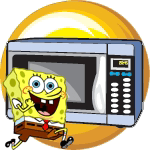Not sure if I ever saw this in a Hints from Heloise column but it’s the kind of news that shows us again that some obvious solutions are easy, inexpensive and right under our noses.
Who knew that microwave ovens can sterilize sponges?
 Microwave ovens are famous for cooking or heating the food but the appliance that cooks food by means of high-frequency electromagnetic radiation can also help in keeping bacteria away from taking over kitchen, a team of environmental engineers from the University of Florida reported on Monday, January 22.
Microwave ovens are famous for cooking or heating the food but the appliance that cooks food by means of high-frequency electromagnetic radiation can also help in keeping bacteria away from taking over kitchen, a team of environmental engineers from the University of Florida reported on Monday, January 22.
Working as a sterilizer, this kitchen device sanitizes the household sponges and plastic scrubbers, known to be common carriers of the bacteria and viruses that cause food-borne illnesses, with its microwave radiations rapidly and effectively, meaning that people can use their microwaves as an inexpensive and effective weapon against E.coli, salmonella and other bugs at the root of increasing incidents of potentially deadly food poisoning and other illnesses.
In their study, published this week in the American Journal of Environmental Health, the U.S. researchers have said that two minutes in a microwave can sterilize sponges and dishcloths after use, killing more than 99 per cent of the harmful bacteria that cause illness.
“Basically what we find is that we could knock out most bacteria in two minutes. People often put their sponges and scrubbers in the dishwasher, but if they really want to decontaminate them and not just clean them, they should use the microwave,” said lead author Gabriel Bitton, a professor of environmental engineering at the University of Florida.
Following are some comments of microwaving sponges and the conditions under which the University of Florida carried out its experiments, not addressing any other conditions nor other materials:
- Sponges used in our study: The sponges we used were all cellulose sponges (O-cel-O from 3M Co. and the Williams Sonoma Pop-Up sponges; no official endorsement is implied). We have no data on synthetic sponges, Loofah sponges or any other sponges.
- Microwave oven used: The microwave oven used in our study has a power of 1,100 watts (which is the power found in many consumers’ ovens). We generally microwaved the sponges at 80%-90% power level.
- Exposure time: In the study, it was found that exposure of the sponge for 2 minutes is sufficient for most applications. However, the sponges have to be fully soaked with water before microwave treatment.
- Metallic pads: No metallic scrubbing pads should be put in the microwave.
- Soapy sponges can be microwaved (you might see soap bubbles forming during microwaving). Do not microwave sponges containing detergents or other chemicals as they may release some undesirable and potentially toxic fumes.
- Beware of hot sponges after exposure to microwave.
- Consumers should use common sense in trying to zap their sponges in their kitchens. If they have a microwave oven with a higher power or sponges with a different chemical composition, they should exercise caution.
Another article reminds us NOT to put dishcloths in microwave ovens:
“Attempting to sterilize a dishcloth in this way is extremely dangerous. There are too many variable factors such as the capacity/power of the microwave oven or the moisture content of the dishcloth or sponge. Scalding is another potential hazard.”